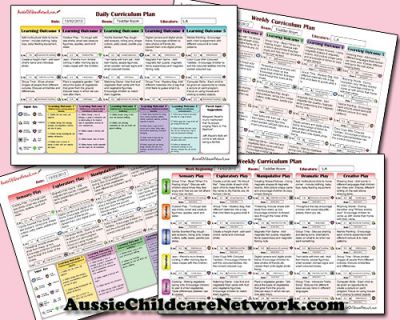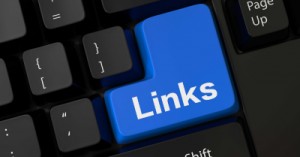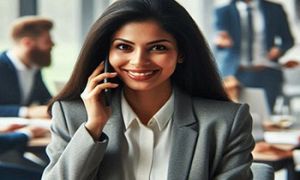The Early Years Learning Framework describes the curriculum as “all the interactions, experiences, activities, routines and events, planned and unplanned, that occur in an environment designed to foster children’s learning and development”.
Please note: I understand that the information in this article needs to be updated to make it more relevant and up to date with the EYLF. This article was written back in 2009-11 when the EYLF had just begun. Now from what we have learnt there are different ways and approaches in documenting the EYLF. This article will be updated over the next few weeks or so. Also remember to check out our collection of EYLF Templates available in this site for LDC, FDC and OOSH settings in this link here: EYLF Templates
The Childcare Curriculum Plan is a planned sequence of activities and experiences, which are intended to achieve an outcome. This means, all the activities / experiences that the children engage in on a daily basis, have an aim / objective and are planned to be available for the group of children on that specific day.
What is a Curriculum Plan
The curriculum plan is a document that lists all the experiences, events and activities that are available for the children throughout the course of the day. The experiences and activities planned on the curriculum plan are follow up, extension ideas, based on children’s interest, family input, intentional teaching etc. and are sourced from a variety of documents such as the daily dairy, observations, learning stories and more.
As part of implementing a curriculum plan, documentation (daily diary, learning stories and observations) becomes a resource tool that is used to reflect on and extend upon the children’s learning and development. This is done by linking further learning opportunities from these documents to the curriculum plan.
Each experience on the curriculum plan is intentional and must have a learning outcome (objective) based on the EYLF, a reason why that particular experience is being provided and clearly states where the experience originated from (through input keys). This provides a clear link to the learning objective and to the original source or specific documentation of where this experience originated from.
Collecting Evidence of Learning
When thinking about what experiences / activities to implement on the curriculum plan (previously known as “program”), information or evidence needs to be gathered which supports children’s learning and development. The collection of evidence you gather to form your curriculum should come from a variety of sources. Once the sources have been collected, these can be used to make up the curriculum plan. The collection of evidence and the information gathered should come from the following sources:
- Children’s Interests
- Child Input / Family Input / Community Events
- Intentional Teaching
- Children’s Portfolios
- Learning Stories
- Daily Diary – Reflections Of Our Day
- Spontaneous Experiences
- Observations
- Continuation Of Children’s Learning
- Group Experiences
- Extension Ideas
- Supporting Skills and Development
- Parent Input/ Suggestions
Through planning, once this information and evidence of learning is collected, the curriculum plan will begin to take shape. This is the process of “designing a curriculum” with children rather than “programming” for children’s learning.
The Curriculum Plan Format
Once the information and evidence has been gathered, the curriculum plan format can begin to take shape. The EYLF doesn’t provide a specific format on how the curriculum plan should be however it does have a specific emphasis on play based learning and teaching, which should be one of the practices included in the curriculum plan. There is no right or wrong way on how the curriculum format is developed. Each individual educator and early childhood setting will have their own thoughts and ideas on how to implement the elements of the EYLF and how the curriculum format will be created. In saying this, there are a few options on what headings (where each experience falls under) can be used when formatting the curriculum plan. Headings on the curriculum plan can include the following:
Learning Outcomes – Using each learning outcomes as a heading on the curriculum plan is a simple way to identify the objective or goal for each experience planned. It enables educators to quickly determine which outcome the children should achieve through each experience.
Play Based Learning - To emphasis a play based learning approach within the curriculum plan the following headings can be used: Sensory Play (learning through senses), Exploratory Play (learning by finding out), Manipulative Play (learning by touch/feel/manipulating), Dramatic Play (learning by role-taking/pretending) and Creative Play (learning by creating). The headings also support the types of play the children will be engaged in throughout the day within their learning environment.
Child Development - Developmental domains can be used as categories within the curriculum plan. Since the EYLF has been introduced there seems to be less focus on a child’s developmental stages and more focus on the learning outcomes. These two can be incorporated and be used together to determine a child’s overall achievements. The learning outcomes are similar and reflect upon the developmental domains:
- L/O 1 – Children Have A Strong Sense of Identity relates to Emotional Development
- L/O 2 – Children Are Connected With & Contribute To Their World relates to Social Development
- L/O 3 – Children Have A Strong Sense of Wellbeing relates to Physical Development
- L/O 4 – Children Are Confident and Involved learners relates to Cognitive Development
- L/O 5 – Children Are Effective Communicators relates to Language Development
Interest Areas - When setting up the physical environment into interest areas, this can be reflected onto the curriculum plan format. The experiences/activities the children will be engaged in can be added under each of the interest areas onto the curriculum plan.
Other Elements in the Curriculum Plan Format
- Headings on the curriculum plan make up the space needed to add each of the experiences in.
- Sub outcomes are to be shown for each experience, even if Learning Outcomes are used as a heading. Sub outcomes enable educators to pin point the desired goal children will achieve through each experience.
- Input keys are a necessity in the curriculum plan format which provides details on where the experience originated from. The links each experience to the source. An icon, image, colour, code can be used as input keys just as long as it is easy identifiable.
- Parent input/suggestions/feedback needs to be added onto the curriculum plan. A parent doesn’t have to write onto the curriculum plan itself, they could be just making a comment or give you a suggestion which then can use to incorporate into the curriculum itself.
How to Write the Curriculum Plan
Once the curriculum plan format has been decided and the “evidence of learning” has been collected, the curriculum plan can now be written. Practice makes perfect and so does writing the curriculum plan. Although it may look like an overwhelming task, it’s really quite simple once all the information has been collected. Here is a simple guide on how to write the curriculum plan.
Experiences / Activities:
Experiences and Activities are added under each of the relevant headings. These are the experiences that the children will be engaged in throughout the week. In order to decide what experiences are to be added onto the curriculum plan, use the collection of documentation from the evidence of learning. Using these, think about an experience to extend upon interests, develop further learning, master a skill, parent suggestions, child input etc. Any of these ideas can form activities for the curriculum plan. When adding experiences onto the curriculum plan, details need to be provided on what the experience is. It doesn’t have to be too detailed, however when someone is reading the curriculum plan they will need to understand what you are referring to. So, it’s a good idea to add a little detail if necessary.
For example:
- Train Table with Train Set – Add train tracks, people figurines, small wooden rail road signs and coloured blocks.
When writing up the experiences it is not necessary to include all the equipment within the room. The physical environment set up usually stays the same (block area, book corner, writing centre, puzzle shelf etc.). On the curriculum plan, record any specific extra equipment, experiences/activities and changes that will be placed in the setup of the room.
Learning Outcomes:
For each experience written on the curriculum plan a learning outcome needs to recorded and identified. Think about and identify which learning outcome the children will achieve while engaging in that particular experience. More often than not, an experience can fall under more than one learning outcome. When this occurs, choose the outcome that best describes what the children should achieve through that particular experience.
For example:
- L/O 3.2: Children take increasing responsibility for their own health and physical wellbeing.
Input Keys:
The experiences listed on the curriculum plan all have come from somewhere. There is a reason behind having each experience on the curriculum plan in the first place. To reflect this, an input key is required to link the experience to the original source.
For example:
- Child Interest
Date Initiated:
Once the experience is linked to the original source using the input keys, to further support this, a date is to be provided. The date is used to link to the original source of where the experience was first initiated or thought of. This means that for any of the experiences provided on the curriculum plan, using the date initiated and the input key, educators can go back and identify where the experience started. It used to help keep track and link experiences to documentation.
For example:
- 8/7/2013
Parent Input:
On the curriculum plan parent input needs to be added on a weekly basis. The simplest way to add parent input into the curriculum plan is to listen to what parents say during pickups and drop offs. They will more than likely discuss what they did on the weekend, what their child is doing at home, new skills developed etc. Use this information to form parent input. When a parent mentions something about their child who can be used as parent input, add it onto the curriculum plan along with the date.
For example:
Taylor’s mum Tiffany mentioned that they will be moving soon. This can be added onto the curriculum under parent input. An extension experience could be a group discussion on what types of houses the children live in. Parents don’t need to physically write down the information you can do it for them.
Curriculum Reflection Questions
Incorporated within the curriculum plan, reflection questions can be added for educators to critically reflect on how the overall atmosphere in the environment is working. The questions are to be used as a tool to guide educators in their professional development. Questions can include:
- Do experiences and activities planned cover each of the EYLF L/O
- Does the curriculum assist in the development of Belonging, Being and Becoming
- Has parent input been added into the curriculum plan
- Is the current setup of the environment working
- Anything to follow up in regards to children, parents and staff
NQS – Quality Area 1: Education Program and Practice
Written plans and evaluations underpin practice with children and families and enhance the accountability and professionalism of the service. Documenting children’s experiences and their responses to the environment makes children’s learning visible to children, educators and families and promotes shared learning and collaboration.
Under the Education and Care Services National Law Act 2010 approved providers and nominated supervisors must ensure that a program is delivered to all children being educated and cared for by the service that:
- is based on an approved learning framework; and
- is delivered in a manner that accords with the approved learning framework; and
- is based on the developmental needs, interests and experiences of each child;
- is designed to take into account the individual differences of each child.
Element 1.1.1: The Early Years Learning Framework (or other approved learning framework) guides curriculum decision making and enables each child’s learning in the five outcomes:
- A learning framework is an important tool for helping educators to work with children and families to achieve the best learning and developmental outcomes for children. Examples of everyday practice include:
- educators and children displaying behaviours and engaging in activities consistent with the evidence for the five outcomes as described in the Early Years Learning Framework
- providing children with a wide range of everyday materials
Element 1.2.1: Each child’s current knowledge, ideas, culture and interests provide the foundation for the program:
- examples of how the nominated supervisor, educators and coordinators plan holistic programs that are responsive to children’s lives, interests and learning styles and which promote children’s physical, personal, social, emotional and spiritual wellbeing as well as the cognitive aspects of learning
The Curriculum Plan Templates
The Curriculum Plan templates available in Templates page on this site have been designed specifically to reflect the key elements and practices within the EYLF. There are 2 types of templates available at the moment. One format uses Play Base Learning as headings and the other uses Learning Outcomes as headings, both formats are either daily or weekly curriculum plans. Each of the templates provides areas to add experiences, sub outcomes, input keys, and parent input. In each of the curriculum plans it also lists each of the 5 learning outcomes along with their sub outcomes and curriculum reflection are also included to support educators reflect on their care practices. There are different version of these templates for Long Daycare, Family Daycare and OOSH Before and After School care settings that are available.
Click here to go to the Curriculum Plan templates: Curriculum Plan Templates
The EYLF curriculum plan is one of the most important documents needed for every early childhood setting. The experiences that are planned are not just setup to entertain the children, they are intentional and are developed to enhance children’s learning, development and care.







 Here is the list of the EYLF Learning Outcomes that you can use as a guide or reference for your documentation and planning. The EYLF
Here is the list of the EYLF Learning Outcomes that you can use as a guide or reference for your documentation and planning. The EYLF The EYLF is a guide which consists of Principles, Practices and 5 main Learning Outcomes along with each of their sub outcomes, based on identity,
The EYLF is a guide which consists of Principles, Practices and 5 main Learning Outcomes along with each of their sub outcomes, based on identity, This is a guide on How to Write a Learning Story. It provides information on What Is A Learning Story, Writing A Learning Story, Sample
This is a guide on How to Write a Learning Story. It provides information on What Is A Learning Story, Writing A Learning Story, Sample One of the most important types of documentation methods that educators needs to be familiar with are “observations”. Observations are crucial for all early childhood
One of the most important types of documentation methods that educators needs to be familiar with are “observations”. Observations are crucial for all early childhood To support children achieve learning outcomes from the EYLF Framework, the following list gives educators examples of how to promote children's learning in each individual
To support children achieve learning outcomes from the EYLF Framework, the following list gives educators examples of how to promote children's learning in each individual Reflective practice is learning from everyday situations and issues and concerns that arise which form part of our daily routine while working in an early
Reflective practice is learning from everyday situations and issues and concerns that arise which form part of our daily routine while working in an early Within Australia, Programming and Planning is reflected and supported by the Early Years Learning Framework. Educators within early childhood settings, use the EYLF to guide
Within Australia, Programming and Planning is reflected and supported by the Early Years Learning Framework. Educators within early childhood settings, use the EYLF to guide When observing children, it's important that we use a range of different observation methods from running records, learning stories to photographs and work samples. Using
When observing children, it's important that we use a range of different observation methods from running records, learning stories to photographs and work samples. Using This is a guide for educators on what to observe under each sub learning outcome from the EYLF Framework, when a child is engaged in
This is a guide for educators on what to observe under each sub learning outcome from the EYLF Framework, when a child is engaged in The Early Years Learning Framework describes the curriculum as “all the interactions, experiences, activities, routines and events, planned and unplanned, that occur in an environment
The Early Years Learning Framework describes the curriculum as “all the interactions, experiences, activities, routines and events, planned and unplanned, that occur in an environment


